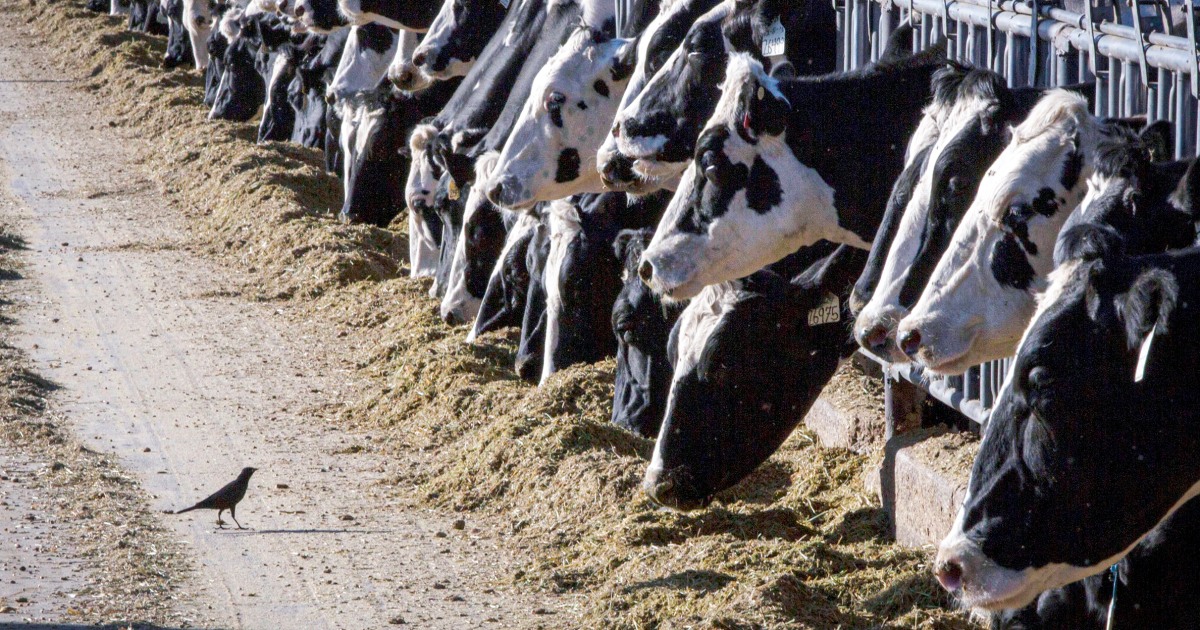
Another human case of bird flu linked to sick dairy cows has been detected in Michigan, marking the third farmworker diagnosed with the illness in the United States since March, the Centers for Disease Control and Prevention reported Thursday. None of the cases are connected.
This is the second farmworker in Michigan in a week to be diagnosed with the illness. And a dairy worker in Texas was diagnosed in March. In those cases, the patients’ only sign of illness was pinkeye, or conjunctivitis.
This latest case is different, however, because the patient also had upper respiratory symptoms, including sore throat, cough and congestion.
During a media briefing Thursday, Dr. Nirav Shah, the CDC’s principal deputy director, said there’s no indication yet that the virus, an A strain of influenza called H5N1, is spreading from person to person, although the risk does increase with respiratory symptoms.
“Simply put, someone who’s coughing may be more likely to transmit the virus than someone who has an eye infection like conjunctivitis,” he said.
The CDC is performing genetic testing on samples of the virus taken from the patient to look for changes that would indicate whether it’s mutating in ways that would allow it to be more transmissible. Those results could be available within days.
The latest patient also had eye discomfort and watery eyes, but it was unclear whether the person had been diagnosed with pinkeye. Like in the previous cases, the patient was given Tamiflu and was reportedly recovering.
Dr. Natasha Bagdasarian, chief medical executive for the Michigan Department of Health and Human Services said that neither of the sickened Michigan workers had been wearing full personal protective equipment, or PPE, when they became infected.
“With the first case in Michigan, eye symptoms occurred after a direct splash of infected milk to the eye. With this case, respiratory symptoms occurred after direct exposure to an infected cow,” Bagdasarian wrote in a press announcement. “PPE is an important tool in preventing spread.”
All of the farmworkers at this latest Michigan dairy are being monitored for symptoms. The CDC recommended that anyone who comes into contact with a sick cow watch for symptoms for 10 days.
As many as 67 herds in nine states have been affected, according to the U.S. Agriculture Department. In addition to herds in Michigan, dairy cattle in Colorado, Kansas, Idaho, New Mexico, North Carolina, Ohio, South Dakota and Texas have also tested positive for bird flu.
“Given the extent of the spread of this virus in dairy cows, additional human cases in people with higher risk exposures would not be surprising,” the CDC said in a press release.
Federal health officials said that the risk of bird flu to the general public remains low, and that their focus continues to be on the potential risks among dairy workers.
“We should remain alert, not be alarmed,” Shah said. The CDC said that its influenza surveillance systems have not picked up any unusual flu activity.
Preparing doses of bird flu vaccine
The Department of Health and Human Services previously said that the government had started the “fill and finish” process of about 4.8 million doses of a bird flu vaccine. That process is likely to last until later this summer, said David Boucher, director of infectious diseases preparedness at HHS’ Administration for Strategic Preparedness and Response
At that point, the Food and Drug Administration would have to consider whether it is necessary to authorize such a vaccine.
Boucher said it would premature to speculate on who might be first in line for the shots.
This is the fourth case of H5N1 overall in the U.S. An inmate in Colorado who had been working on a farm culling birds suspected to be infected with bird flu was diagnosed in 2022. His only symptom was fatigue.
Globally, less than 1,000 cases of H5N1 in humans have been identified. CDC data shows that more than half of those patients died, but that death rate may be an overestimate as mild cases may go undetected.
The CDC recommends that anyone in contact with dairy cattle — including bedding and animal feces — wear protective equipment, including safety glasses, waterproof aprons and boots that can be sanitized.
The agency also said that people should not drink unpasteurized raw milk.






